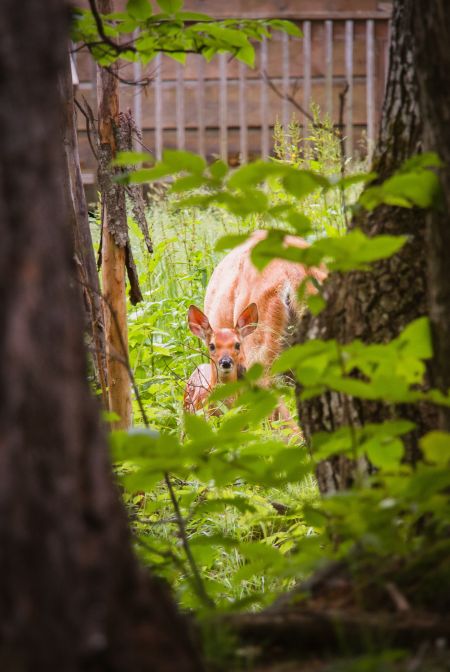Deer Trouble? How To Get More Garden Goodness For You And Less For Them
Eat more veggies that's what it's all about, right?
Or grow more flowers for yourself and the bees?
But what about when the deer haven't gotten that memo?
What about when they come in and take big bites out of everything you've worked hard to plant including your tomato plants, your lettuce, and sunflowers?
That's what I'm here for today. To help you outwit the deer.
Because believe me do we have experience in doing just that.

Whether you're going for veggies and flowers for your family or flowers for the wildlife, the deer are liable to mess up your plans, if you live in a high deer area.
To me there are two ways to approach avoiding the damage deer can do to your garden:
- Planting deer resistant plants that they won't eat.
- Excluding the deer.
What are deer resistant plants for your garden?
A common question I get is:
What are deer resistant plants for my garden?
Luckily, there are many choices in the deer resistant category!
So many choices that I'm going to add the caveat of it's okay if we don't agree! Everyone has different experiences and this list mostly reflects our own experience and we acknowledge that there is no universally accepted deer resistant plant list.
Deer resistant annual veggies:
A comment here is that deer will eat just about anything if they are waaaay out of control. Even garlic or hot peppers. Here is a list of what they don't eat under moderate deer pressure.
- Broccoli
- Kale (before frost)
- Cabbage
- Potatoes
- Leeks
- Onions
- Peppers
- Rutabaga
- Turnips
- Daikon/Winter radishes
- Garlic
- Bok choy
- Other Asian greens
- Corn
- Arugula
- Brussels Sprouts
- Cauliflower
- Kohlrabi
- Eggplant
- Parsnips
Intermediate annual vegetables:
Deer can and will eat these sometimes.
- Tomatoes
- Kale after frost
Deer attracting annual vegetables:
The flip side is here are the things they really like and you might want to watch out for and fence or cover these.
- Carrots
- Cilantro
- Dill
- Lettuce
- Squash/zucchini/pumpkin
- Cucumbers
- Peas
- Beans
- Radicchio
- Fennel
- Beets
- Swiss Chard
- Parsley
Deer resistant annual flowers:
- Calendula
- Cosmos
- Snapdragon
- China aster
- Zinnias
- Borage
- Batchelor's buttons
- Larkspur
- Sweet William
- Celosia
- California poppy/other poppies
Deer resistant herbs:
- Basil
- Chives
- Lavender
- Oregano
- Rosemary
- Marjoram
- Mints
- Sage
- Thyme
Deer resistant perennials:
This is a list of perennials that we grow and sell that are deer resistant. This is not exhasutive by any means as there are many many more plants, trees and shrubs that we don't grow that are deer resistant.
- Achillea millefolium White Yarrow
- Achillea millefolium Summer Pastels Yarrow
- Actaea rubra Red Baneberry
- Ageratina altimissa White Snakeroot
- Alchemilla mollis Lady's Mantle
- Allium cernuum Nodding Onion
- Allium schoenoprasum Chives
- Amsonia tabernaemontana Willowleaf Bluestar
- Aquilegia canadensis Wild Columbine
- Armoracia rusticana Horseradish
- Arnica chamissonis Meadow Arnica
- Artemesia absinthium Wormwood
- Asarum canadense Wild Ginger
- Asclepias incarnata Rose Milkweed
- Asclepias syriaca Common Milkweed
- Asclepias tuberosa Butterfly Milkweed
- Campanula americana Tall American Bellflower
- Campanula rotundifolia Scotch Bellflower (Harebell)
- Chamaepericlymenum canadense Bunchberry
- Chamerion angustifolium Fireweed
- Chelone glabra White Turtlehead
- Clematis virginiana Virgin's Bower
- Coreopsis palmata Prairie Coreopsis
- Echinacea paradoxa Bush's Coneflower
- Echinacea purpurea Purple Coneflower
- Eupatorium perfoliatum Boneset
- Eutrochium maculatum Joe Pye Weed
- Eutrochium purpureum Sweet Joe Pye Weed
- Fragaria vesca Alpine Strawberry
- Fragaria virginiana Wild Strawberry
- Helenium autumnale Helen's Flower Mix Sneezeweed
- Heliopsis helianthoides Early Sunflower
- Hypericum prolificum Shrubby St. John's Wort
- Hyssopus officinalis Hyssop
- Inula helenium Elcampane
- Iris versicolor Blue Flag Iris
- Lavendula angustifolia Munstead Lavendar
- Leucanthemum x superbum Crazy Daisy
- Liatris novae-angliae New England Blazing Star
- Liatris pycnostachya Prairie Blazing Star
- Liatris spicata Dense Blazing Star
- Lobelia cardinalis Cardinal Flower
- Lobelia siphilitica Great Blue Lobelia
- Mertensia virginica Virginia Bluebells
- Monarda bradburniana Bradbury's Monarda
- Monarda didyma Panorama Red Bee Balm
- Monarda fistulosa Wild Bergamot
- Oligoneuron rigidum Stiff Goldenrod
- Origanum vulgare hirtum Greek Oregano
- Penstemon digitalis Foxglove Beardtongue
- Physostegia virginiana Obedient Plant
- Polemonium reptans Jacob's Ladder
- Pycnanthemum muticum Clustered Mountain Mint
- Pycnanthemum virginianum Virginia Mountain Mint
- Rudbeckia fulgida Orange Coneflower
- Rudbeckia hirta v. pulcherrima Blackeyed Coneflower
- Salvia azurea Blue Sage
- Salvia officinalis Garden Sage
- Sambucas canadensis Elderberry
- Sambucas racemosa Red-Berried Elderberry
- Sanguinaria canadensis Bloodroot
- Silphium perfoliatum Cup Plant
- Solidago caesia Blue-stem Goldenrod
- Solidago ulmifolia Elm-Leaved Goldenrod
- Spirea tomentosum Steeplebush
- Thermopsis caroliniana Blue Ridge Buckbean
- Thymus vulgaris German Winter Thyme
- Tradescantia ohiensis Ohio Spiderwort
- Verbena hastata Blue Vervain
- Verbena stricta Hoary Vervain
- Veronicastrum virginicum Culver's Root
- Viola sororia Common Blue Violet
How to exclude deer
We've tried a lot of things and the one thing I can tell you is that getting a nuisance permit to shoot the deer may or may not work. We've tried it and they still come back.
General practices and tips:
One thing that works great for us is targeting our protection. Using the list above we use deer exclusion on the things that we know they're going to eat and let them roam wherever they want to on most of the farm where we know they're not going to do very much damage. We've found that allowing them free passage through most of our property makes them less likely to try to breech our defenses around their favorite plants (like carrots!).
Another tip is if you know that the deer are going to go for something, use deer exclusion methods right when you plant it so that they never get an easy taste of it in the first place. This works really well for us! If they have to work for their first taste of it then they are much less likely to actually try to taste it.
Remember deer are going for a joy ride in the garden. If it's easy grazing, they'll eat it. But, they're not hitting your garden because they're starving. If they have to work for it they might decide it's not worth it.
Specific exclusion tactics:
- Electric fencing—This is what we use. You can use multiple lines or a net fencing. If you have low or medium pressure, this could be enough to form a psychological barrier for them not to jump over. Pros: Easy to move around to a new location. Cons: Expensive to get started and you have to have a charger also.
- Regular wire (non-electric) tall fencing—This is the best option for high pressure. Make it at least 8 ft high to prevent them from jumping in. Pros: once you get it set up it doesn't take much maintenance. Cons: High cost in initial set up.
- Row cover—We use row cover to keep the deer away from plantings at times. It works with low to medium pressure situations and deters them because they'd have to paw through it to get at the crop below which they don't like to do very much. Except for carrots in October/November which they'll destroy row cover to get at. Pros: easy to put down and take up and reuse. Cons: expensive and deer can paw through it and ruin your fabric.
- Heavy duty tarp—We use a heavy duty tarp to cover carrots and other root crops from the deer in a very high pressure situation in a temporary fashion. They can't paw through it so that stops any activity they've started. Pros: works! Cons: It's heavy to move the tarps around and weigh them down. It only works in the fall on things that have already done their growing as it blocks light transmission and mashes the tops pretty bad.
- Deer spray—We have never tried this, but people say it works. There is an organic option called PlantSkydd that the Soil and Water District sells. Or you can make your own using cayenne.
- Other light duty scare tactics—Motion sensitive lights, laser lights, noise makers, scents, or sprinklers all could work in the right situation. We have not had luck with any of these options though.



Add new comment
Comments (1)
deer
Fri, 2022-06-03 08:56